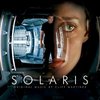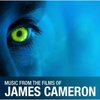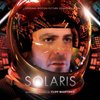Soundtrack Information

Solaris
Superb Records (TRM-74070-2)
Release Date: December 10, 2002
Conducted by Bruce Fowler
Formats: CD, Digital
Music From
Music By
Purchase Soundtrack
Track Listing
Related Albums

Solaris - Limited Vinyl EditionBlack 180 Gram 1,000 Copies / White 1,000 Copies / Picture Disc 1,000 Copies
InvadaReleased: November 26, 2013
Format: Vinyl

Music from the Films of James CameronSilva Screen Records, Ltd. (SILED4516)
Released: May 4, 2010
Format: Digital (51 min)

Cult Cuts - Music from the Modern CinemaSilva Screen Records, Ltd. (SILCD1270)
Released: March 9, 2009
Formats: CD, Digital (63 min)
Review: Solaris
3 / 5 Stars
We each have those directors, don't we? Those film makers whose pictures inspire and delight us, cause us to think and see the world in differing colors. We look forward to their releases like a child wishing for a Red Rider B-B gun for Christmas. Steven Soderbergh is just such a director for me.
Soderbergh has traversed a breadth of film genres in his career and when it was announced that he was re-telling of Stanislaw Lem's Solaris (previously made into a film by Andrei Tarkovsky), like many others I wanted anxiously to see the results of his exploration of science fiction. What did not come to mind, however, was what sort of music his long-time collaborator Cliff Martinez would craft for the film. Soderbergh's films are not held up in the film music world as brimming with new, exciting music and the pairing of Soderbergh/Martinez is seldom invoked compared to Spielberg/Williams or Burton/Elfman. Martinez's scores do not have the tunefulness of many film compositions and are therefore often overlooked. Yet for over ten years, he has been providing musical subtext to Soderbergh's visual and narrative innovations.
Music for science fiction films traditionally fall into two categories: 1. strings and, for lack of a better phrase, "other-worldly sounds" such as the Theremin, create an intense sound that is, at the same time, cold and keep the audience at a distance from the action. Bernard Hermann's masterful score to The Day the Earth Stood Still is a classic example of this style. 2. an orchestra of Wagnerian proportions uses sweeping figures and grand leitmotifs to carry the audience away on an interstellar adventure. John Williams's Star Wars scores set the pattern for this style. Soderbergh, in crafting an emotional exploration in space that is immediate yet distant, wisely encouraged Martinez to strike a balance between these two extremes. With Solaris, Martinez has provided an essay in the burgeoning third category of science fiction scoring, that of the ambient or atmospheric score.
Martinez began his musical career as a drummer for The Weirdos, Lydia Lunch, Captain Beefheart, The Dickies and, most famously, the Red Hot Chili Peppers. (In 1989 he left the Peppers because, as he says, "I decided I didn't really want to be wearing a sock on my weiner for the rest of my life.") His experience as a drummer is clearly evident in his instrumentation in Solaris. To the standard string orchestra with light brass and woodwinds, Martinez adds understated electronics, celesta, steel drum, and a gamelan ensemble. A Javanese gamelan is the Indonesian orchestra of bells, gongs, and drums that has captivated Western composers since Debussy first encountered it at the Paris Universal Exhibition in 1889. In Solaris, its delicate, shifting tone colors in a decidedly non-equal tempered scale underlie the remoteness of the action and the sentient planet while the repetitive, cyclic nature of its music provide a comforting space from which the audience can watch the proceedings.
The overall arch of the score is fairly static, with shifting tone colors and textures providing the majority of musical propulsion and interest. This uniformity of sound serves to unify the picture emotionally in much the same way as Philip Glass's score for The Hours, but a few cues stand out for Martinez's treatment of the orchestra and their narrative impact. "Will She Come Back" opens with delicate electronics that sound almost like pure sine-tones. Then listen how he slowly undergirds and replaces those sounds with close, dissonant strings and begins to softly punctuate moments with bells. When the full strings finally enter halfway through with an elegiac melody, the poignancy of the main character's grief and apprehension are well-established.
"Wear Your Seat Belt" is the antithesis of "Will She Come Back," or at least as opposite as is possible on this homogenous score. It begins with the gamelan pulsations over which strings and electronics play in a tightly woven, dissonant, and eerie cloud. The gamelan slowly takes over the foreground from the strings, moving into a higher and higher register until the bottom falls away, leaving the listener floating free.
As a listening experience separate from the film, Solaris provides interesting colors, but ultimately recedes into the background without engaging the listener. It is well-crafted and suited to the film it accompanies, drawing out the narrative emotions that Soderbergh obviously desired, but is cold and distant without the support of moving images. While I still look forward to each Soderbergh film as an integrated work of art, the possibility of a new score fails to generate anything more than the peaceful stasis of Solaris.
-
Click stars
to rate.
If any information appears to be missing from this page, contact us and let us know!

